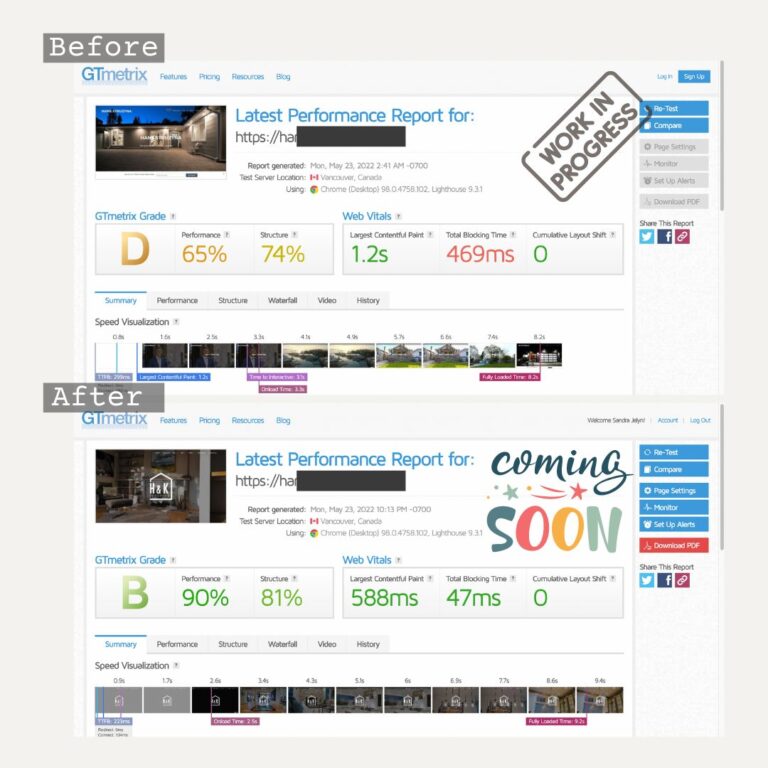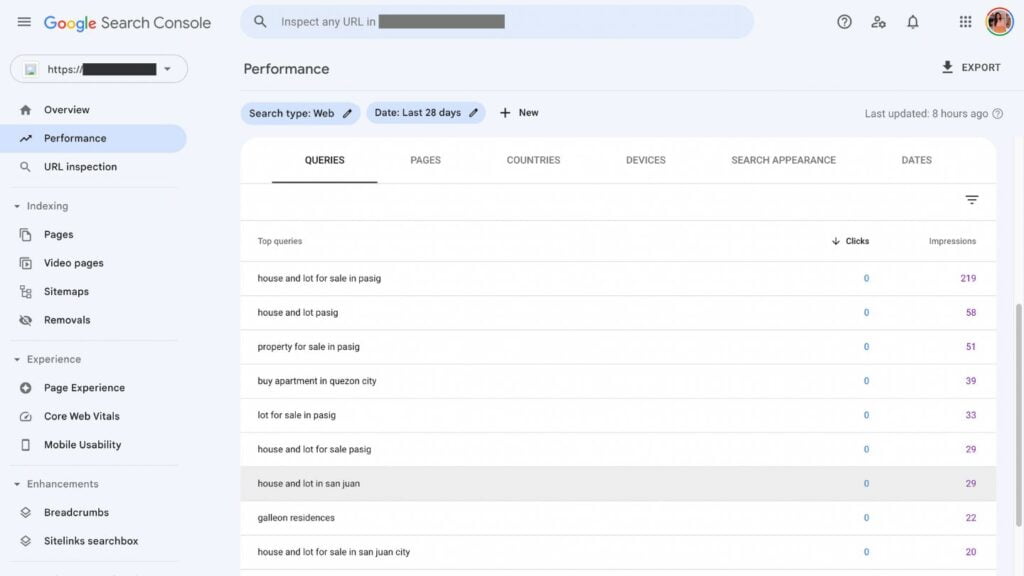Top 10 Real Estate Website Pain Points and How To Overcome Them
In the featured picture: my smile after identifying a prospective client’s website pain points and being able to suggest solutions on how to address them.
So what are the top major real estate website pain points?
Let me share with you the top 10 that I’ve encountered personally, both from casually studying other people’s websites or doing audits.

1. “My website takes too long to load.”
One of the most significant pain points for real estate website owners is a slow-loading website. People have a short attention span when browsing websites, and if your website takes too long to load, they’re likely to move on to the next one. According to Neil Patel, 40% of people abandon a website that takes longer than three seconds to load.

To overcome the slow loading time of websites, one of the things we can do is to make use of GTMetrix.
GTMetrix is a website performance testing tool that helps website owners and developers analyze the speed and performance of their website.
The tool provides a comprehensive report that includes data on website loading time, page size, number of requests, and other key performance indicators. It also offers suggestions on how to improve website performance, such as optimizing images, minifying code, and reducing the number of HTTP requests. By using GTMetrix, website owners and developers can identify performance issues and take steps to improve their website’s speed and user experience.
2. “It is not mobile-friendly.”
With more people using mobile devices to browse the internet, having a mobile-friendly website is no longer optional. A mobile-friendly website is not only essential for the user experience but also for search engine optimization.
Google now uses mobile-first indexing, meaning that it primarily uses the mobile version of a website for indexing and ranking. To ensure that your website is mobile-friendly, we must always make sure to use best practices for responsive design, which means that the website’s layout automatically adjusts to fit the screen size of different devices, making it look nice on different devices being used.
3. “The design is outdated.”
A website with an outdated design can give the impression that your business is also outdated.
To overcome this pain point, update your website’s design with a modern, visually appealing design that’s in line with current design trends.
4. “The pages aren’t optimized for search engines.”
Search engine optimization (SEO) is crucial for driving traffic to your website. If your website is not optimized for search engines, it won’t appear in search engine results pages (SERPs) when people search for real estate in your area.
To overcome this pain point, use keyword research to identify the terms people are searching for and optimize your website’s content accordingly. Then, make sure to use those keywords in your website’s meta tags, headings, and content.
5. “Plugins are negatively affecting the site’s performance.”
While plugins can be great for adding functionality to your website, they can also slow down your website’s performance if they’re not properly optimized or if you have too many of them.
To overcome this pain point, make sure to always do your research on which plugins are best to use which also do not affect your site’s performance, deactivate and delete the plugins that are no longer necessary, and keep the ones that are active updated to keep your website secure, functional, and up-to-date with the latest features.
6. “I’m not getting enough traffic.”
If your website is not receiving enough traffic, it’s likely due to a combination of the issues listed above.
To overcome this pain point, I wrote a separate blog post on my Top 7 favorite (and also proven and tested) ways to get more people to visit your site. Make sure to check that out!
7. “I’m getting enough traffic but it isn’t converting.”
If you’re getting plenty of traffic to your website but aren’t seeing a corresponding increase in leads or sales, it’s likely due to issues with your website’s design or user experience.
To overcome this pain point, make sure your website’s design is easy to navigate and aesthetically pleasing. More importantly, use clear and easy to follow calls-to-action (CTAs) to encourage visitors to take action, such as filling out a form, calling, or booking a consultation with you.
8. “I’m missing out on backlinks.”
Backlinks are links from other websites that direct traffic to your website. They are an important factor in determining your website’s search engine ranking, as search engines view them as a sign of credibility and authority. Without backlinks, your website is less likely to appear at the top of search engine results pages. It’s important to actively work on getting backlinks from reputable sources to improve your website’s SEO.
9. “I hired someone to do the site for me, and now I don’t know how to update my own content.”
Another common pain point for website owners is the inability to update content. If you hired someone to build your website and now find yourself unable to make changes or update your own content, it may be time to find a new solution. Fresh, relevant content is important for improving your website’s search engine ranking, so being able to update your website regularly is crucial.
10. “I’m not sure what topics or keywords I should write about to help my site rank higher on Google.”
Creating content that targets the right keywords is essential for improving your website’s search engine ranking. If you’re not sure what topics or keywords to focus on, it’s time to develop a content strategy.
A content strategy involves identifying the topics and keywords that your target audience is searching for and creating content that addresses those topics. This can help you rank higher in search engine results pages and attract more traffic to your website.
One of the tools that my clients and I are using to help us develop a content strategy is Google Search Console.
Google Search Console’s “Queries” function helps website owners see what keywords people are searching for on Google, and how often their website appears in the search results for those keywords. In other words, it provides data on the specific search terms that people use to find your website.
This information can be useful in optimizing your website’s content to better match what people are searching for, as well as identifying opportunities to improve your website’s ranking in search results for certain keywords.

Bonus: "I like my competitor’s website design better."
Finally, it’s common to feel envious of a competitor’s website design. However, instead of feeling discouraged, you can use it as inspiration to improve your own website’s design. A visually appealing website can improve user experience, which can ultimately lead to more conversions and sales.
In conclusion, owning a real estate website can be a challenging task, especially when you’re facing major pain points that can hinder your online success. However, by understanding these challenges and implementing the right strategies to overcome them, you can turn these pain points into opportunities for growth and success. Whether it’s addressing issues related to website speed, mobile responsiveness, content strategy, or search engine optimization, there are always ways to overcome these challenges and stay ahead of the competition. By keeping an eye on the latest trends and best practices, you can ensure that your real estate website continues to thrive and deliver value to your audience for years to come.
Do you have anything you want to add to this list? Or are you a real estate broker or agent who needs help with their website?
We’d love to help you! Just send us a message!





